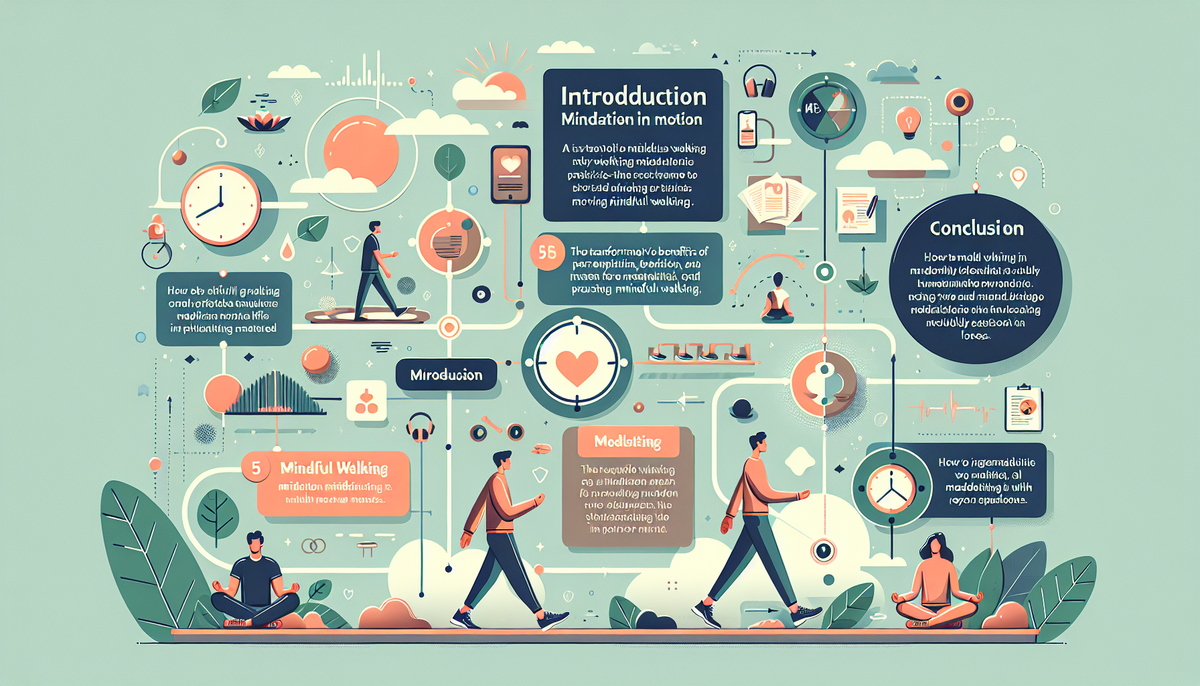Mindful Walking: Meditation in Motion

Mindful Walking: Meditation in Motion
Mindful walking is an accessible and powerful awareness practice that combines the physical benefits of walking with the mental clarity of meditation. It is a form of moving meditation that transforms a simple, everyday activity into a profound experience of presence and connection. By bringing our attention to the physical sensations of our bodies and the environment around us, we can cultivate a state of relaxed awareness that can be carried into all aspects of our lives.
What is Mindful Walking: More Than Just a Walk in the Park?
At its core, mindful walking, often called walking meditation, is the practice of bringing your full attention to the act of walking. Instead of letting your mind wander to the past or future, you intentionally focus on the present moment. This simple shift in awareness can have a profound impact on your well-being, turning a mundane activity into a rich and rewarding experience. It’s an effective awareness practice that doesn’t require any special equipment or setting, making it one of the most accessible forms of meditation available.
The Core Principles of Moving Meditation
The foundation of this moving meditation lies in a few key principles. The first is intention—consciously deciding to walk with awareness. The second is attention, directing your focus to the physical sensations of walking, such as the feeling of your feet on the ground, the movement of your legs, and the rhythm of your breath. The final principle is acceptance, acknowledging any thoughts or feelings that arise without judgment and gently guiding your attention back to the present moment. Together, these principles create a powerful framework for cultivating mindfulness in motion.
Mindful Walking vs. Regular Walking: Key Differences
While both regular walking and mindful walking involve the same physical activity, their purpose and focus are vastly different. When we walk normally, our minds are often on autopilot, consumed by thoughts, plans, or worries. In contrast, mindful walking is an active awareness practice. The goal is not to get somewhere, but to be fully present with each step. This distinction is crucial; it elevates walking from a mere mode of transportation to a dedicated practice of mental and sensory engagement, fostering a deeper connection with your body and your surroundings.
The Transformative Benefits of Mindful Walking
This moving meditation offers a wealth of benefits that are supported by both ancient wisdom and modern science. By consistently engaging in this awareness practice, you can experience significant improvements in your physical health, mental clarity, and overall sense of well-being. It’s a holistic practice that nurtures the body, mind, and spirit in unison.
Boosting Physical Health and Coordination
Mindful walking encourages you to pay close attention to your body, which can lead to improved balance, coordination, and posture. The deliberate, gentle pace can be less strenuous on the joints than other forms of exercise, making it suitable for people of all fitness levels. Furthermore, studies have shown that regular walking can help lower blood pressure, improve circulation, and strengthen bones, contributing to better long-term physical health. This awareness practice helps you listen to your body’s needs and limitations more effectively.
Enhancing Mental Clarity and Reducing Stress
One of the most celebrated benefits of mindful walking is its ability to calm the mind and reduce stress. By focusing on the physical act of walking and your sensory experiences, you create a mental anchor in the present moment. This helps to break the cycle of rumination and worry that often fuels anxiety. This form of moving meditation has been shown to decrease symptoms of depression and anxiety, promoting a sense of inner peace and emotional regulation.
Deepening Your Connection with the Present Moment
In our fast-paced world, it’s easy to feel disconnected from ourselves and our environment. Mindful walking is a powerful antidote to this modern ailment. By tuning into the sights, sounds, and smells around you, and the physical sensations within you, you cultivate a rich, grounded experience of the present. This awareness practice helps you to appreciate the beauty in small details and fosters a profound sense of connection to the world and your place in it.
Your Step-by-Step Guide to Practicing Mindful Walking
Getting started with mindful walking is simple. You don't need any special training or equipment, just a willingness to be present. This step-by-step guide will walk you through the process, helping you to begin your own moving meditation journey and establish a consistent awareness practice.
Step 1: Finding Your Pace and Posture
Begin by standing still for a moment. Feel your feet firmly planted on the ground. Keep your back straight but not stiff, and let your arms hang loosely at your sides. When you start to walk, choose a pace that feels natural and comfortable—it might be slower than your usual walking speed. The goal is not to rush but to move with intention and awareness.
Step 2: Focusing on the Sensation of Walking
Bring your attention to your feet. Notice the sensation of lifting one foot, moving it through the air, and placing it back down on the ground. Feel the contact of your sole with the surface beneath you. Pay attention to the subtle shifts in weight and balance with each step. This focus on the physical act of walking is the core of this moving meditation.
Step 3: Engaging Your Senses with the Environment
Expand your awareness to include your other senses. What do you see around you? Notice colors, shapes, and movements without getting lost in stories about them. What do you hear? Listen to the sounds of your footsteps, the rustle of leaves, or the distant city hum. What do you feel? Notice the temperature of the air on your skin or the gentle breeze. This sensory engagement is a key part of the awareness practice.
Step 4: Acknowledging Thoughts Without Judgment
Your mind will inevitably wander—this is completely normal. When you notice your thoughts drifting, gently acknowledge them without criticism or judgment. Then, softly guide your attention back to the physical sensations of walking. Each time you do this, you are strengthening your mindfulness "muscle." This non-judgmental awareness is a cornerstone of all mindfulness practices.
Integrating Mindful Walking into Your Daily Routine
The beauty of mindful walking is that it can be woven into the fabric of your everyday life. You don’t need to set aside a large chunk of time; even a few minutes can make a difference. By finding small opportunities to practice, you can make this moving meditation a sustainable and enriching habit.
The Mindful Commute: Transforming Your Way to Work
If you walk to work or to public transportation, you have a perfect built-in opportunity for a moving meditation. Instead of being lost in thought about the day ahead, use this time to practice mindful walking. Focus on your steps, your breath, and the world around you. This can help you arrive at your destination feeling more centered and prepared for the day.
Lunchtime Practice: A Midday Mental Reset
Your lunch break is another ideal time for this awareness practice. Step away from your desk and take a short, mindful walk, even if it’s just for five or ten minutes. This can help you to de-stress, clear your mind, and return to your work feeling refreshed and refocused. It’s a simple way to break up the workday and re-center your attention.
Connecting with Nature: Mindful Walks in the Outdoors
Practicing mindful walking in a natural setting like a park, a forest, or by a body of water can be especially restorative. Nature offers a rich tapestry of sensory experiences to focus on, from the sight of sunlight filtering through leaves to the sound of birdsong. A mindful walk in nature is a powerful way to deepen your awareness practice and feel more connected to the natural world.
Conclusion: Walk Your Way to a More Mindful Life
Mindful walking is more than just a technique; it's a way of living with greater awareness, presence, and appreciation. This simple moving meditation offers a path to reduced stress, improved health, and a deeper connection with yourself and the world around you. By turning the simple act of walking into an awareness practice, you unlock a powerful tool for cultivating a more mindful and fulfilling life. Take the first step today. Walk on, with awareness, and discover the profound peace that can be found in meditation in motion.



